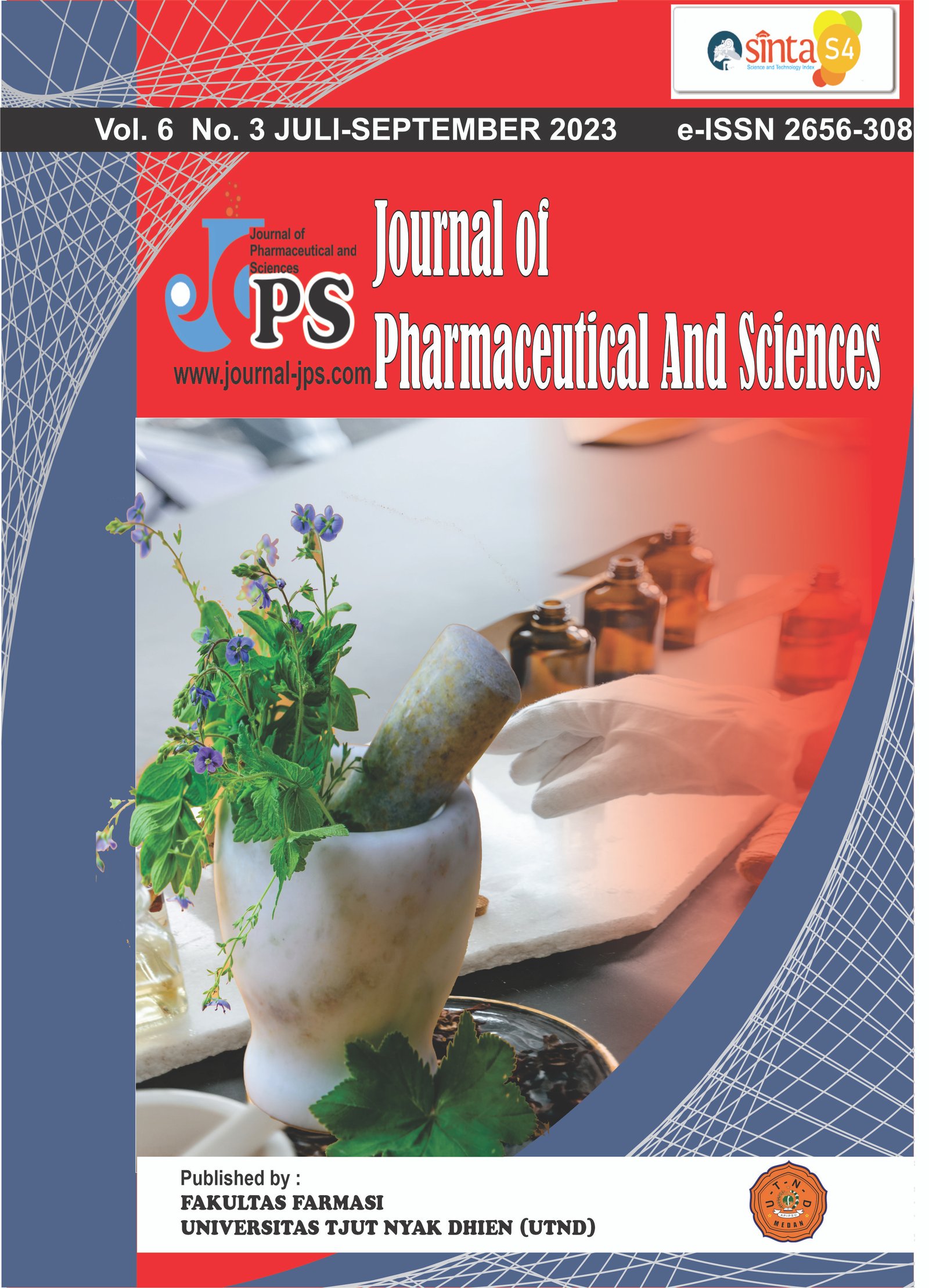Phytochemical Screening and Analysis of Caffeine Content in Arabica Ground Coffee in Takengon City Using Spectrophotometry Ultraviolet
Main Article Content
Page: 998-1006
Abstract
Background: Coffee is a type of plant that contains caffeine and can be made into a delicious drink. Currently, coffee is the world's most popular drink after water and tea. The stuay aimed was to determine the caffeine content in Arabica ground coffee circulating in the Takengon market according to Indonesian national standards (SNI 01-7152-2006). This research was experimental by taking samples purposively. The research method used was phytochemical screening, qualitative analysis, and ultraviolet spectrophotometry at a wavelength of 273nm. The specified validation parameters were precision, linearity, LOD and LOQ. The results of the phytochemical screening of sample A in the Meyer test treatment obtained negative results but the others were positive. And in sample B, all tests were positive. In the three qualitative analyses tests on samples A and B, the results were positive. The average yield of quantitative analysis in sample A was 11.632 mg once and the daily concentration was 34.897mg. while in sample B the level was 6.663 mg once and drank 19.989mg per day. Validation test results obtained linearity r2 = 0.998, LOD and LOQ namely 0.882µg/ml and 2.94µg/ml, RSD value of 1.11%. Based on the conclusion, sample A and sample B met the requirements according to SNI 2006 (50mg once and 150mg daily) and also met the requirements according to the Pharmacopoeia Edition III, namely a maximum dose of 500 mg once and 1.5g daily.
Downloads
Article Details

This work is licensed under a Creative Commons Attribution-NonCommercial-ShareAlike 4.0 International License.
References
Aditya, I. W., Nocianitri, K. A., & Yusasrini, N. L. A. (2015). Kajian Kandungan Kafein Kopi Bubuk, Nilai pH dan Karakteristik Aroma dan Rasa Seduhan Kopi Jantan (Pea berry coffee) dan Betina (Flat beans coffee) Jenis Arabika dan Robusta. Fakultas Teknologi Pertanian, Universitas Udayana.
Andry, M., Faisal, H., & Apila, N. N. (2022). Formulasi dan Uji Aktivitas Antioksidan Sediaan Krim Ekstrak Etanol Daun Asam Jawa (Tamarindus indica L.) dengan Menggunakan Metode DPPH. Jurnal Dunia Farmasi, 6(2), 96–107.
Andry, M., & Luthvia, L. (2022). Simultaneous Content Analysis of Rifampicin, Isoniazid, and Pyrazinamide in Tablet Dosage Form By Spectrophotometry Ultraviolet With Dwm and Rsm. Jurnal Farmasi Sains Dan Praktis, 8(3), 243–251. https://doi.org/10.31603/pharmacy.v8i3.6241
Andry, M., & Winata, H. S. (2022). Uji Aktivitas Antibakteri Streptococcus Mutans serta Formulasi Sediaan Pasta Gigi Ekstrak Etanol Buah Okra Hijau (Abelmoschus esculentus) dan Tulang Ikan Tuna (Thunnini). Journal of Pharmaceutical and Sciences (JPS), 5(2), 170–173.
Elfariyanti1, Silviana, E., & Mela Santika. (2020). Analisis Kandungan Kafein Pada Kopi Seduhan Warung Kopi di Kota Banda Aceh. Lantanida Journal.
Fitri, K., Khairani, T. N., Andry, M., Rizka, N., & Nasution, M. A. (2023). Activity Test of Anti-acne Cream of Lotus Leaves (Nelumbo nucifera g.) Ethanol Extract on Bacteria of Propionibacterium Acnes and Staphylococcus aureus. Journal Pharmaceutical and Sciences, 6(1), 37–45.
K. Fitri, M. Andry, Khairani, T. N., Winata, H. S., A. Violenta, N. Lubis, & Lubis, M. F. (2023). Synthesis of Silver Nanoparticles Using Ethanolic Extract of Nelumbo nucifera Gaertn. Leaf and Its Cytotoxic Activity Against T47D and 4T1 Cell Lines. Rasayan Journal of Chemistrymistry, 16(01), 104–110. https://doi.org/10.31788/rjc.2023.1618000
Khalida Utami, S. D. L. F. (2014). Strategi Pengembangan Usaha Tani Kopi Arabica (Coffea SP ) di Kabupaten Gayu. Journal of Agriculture and Agribusiness Socioeconomics.
Muhammad, A., Effendy, D. L., & Muchlisyam, P. (2019). Simultaneously Content Analysis of Sulfadoxine and Pyrimethamine in Tablet Dosage Form by Spectrophotometry Ultraviolet with Dual Wavelenght Method. Asian Journal of Pharmaceutical Research and Development, 7(4), 34–37. https://doi.org/10.22270/ajprd.v7i4.555
Mulyani, E., & Cahyati, E. T. S. (2019). Analisis Kadar Kafein Pada Kopi Bubuk di Kota Bengkulu Menggunakan Spektrofotometri Ultraviolet. Journal Penelitian Dan Kajian Ilmiah Kesehatan Mataram: Politeknik Medica Farma Husada.
Nasirah Maulidia Ajhar, D. M. (2020). Skrining Fitokimia dan Uji Aktivitas Antioksidan Dari Ekstrak Etanol Biji Kopi Arabika (Coffea arabica) yang Tumbuh Di Daerah Gayo Dengan Metode DPPH. Dalam Journal Sains Dan Ilmu Farmasi Universitas Muslim Nusantara Alwasliyah, Medan.
Pamungkas, B. T., Safitri, A., Rezaldi, F., Andry, M., Agustiansyah, L. D., Fadillah, M. F., … Hariadi, H. (2022). Antifungal Trycophyton rubrum and Trycophyton mentagrophytes in Liquid Bath Soap Fermented Probiotic Kombucha Flower Telang (Clitoria ternatea L) as a Pharmaceutical Biotechnology Product. BIOTIK: Jurnal Ilmiah Biologi Teknologi Dan Kependidikan, 10(2), 179–196. https://doi.org/10.22373/biotik.v10i2.15160
Putri, A. (2021). 7 Manfaat Kafein untuk Kesehatan. Fakultas Keperawatan Universitas Airlangga.
Sigiro, Y. E. K., & Darwanto, D. H. (2020). Analisis Preferensi Konsumen terhadap Kopi Lokal Sumatera di Kota Pematangsiantar. Universitas Gadjah Mada.
Sulistyarini, I., Sari, D. A., & Wicaksono, T. A. (2020). Skrining Fitokimia Senyawa Metabolit Sekunder Batang Buah Naga (Hylocereus polyrhizus). 56–62.
Teniro, Y. W., Zulfan, & Husaini. (2018). Perkembangan Pengolahan Kopi Arabika Gayo Mulai Dari Panen Hingga Pasca Panen di Kampung Simpang Teritit Tahun 2010-2017. Banda Aceh: Universitas Syiah Kuala.
Tjahjani, N. P., Chairunnisa, A., & Handayani, H. (2021). Analisis Perbedaan Kadar Kafein Pada Kopi Bubuk Hitam dan Kopi Bubuk Putih Instan Secara Spektrofotometri UV-Vis. Cendikia Journal Farmacy, 5(1), 52–62.
Winata, H. S., Andry, M., Nasution, M. A., Rezaldi, F., & Sembiring, A. S. F. B. (2023). Anti-Inflammatory Activity of Stem Barks Ethanol Extracts of Asam Kandis On Male White Rats. Journal of Agromedicine and Medical Sciences, 9(1), 47–53.
Zarwinda, I., & Sartika, D. (2019). Pengaruh Suhu Dan Waktu Ekstraksi Terhadap Kafein Dalam Kopi. Lantanida Journal, 6(2), 180. https://doi.org/10.22373/lj.v6i2.3811





